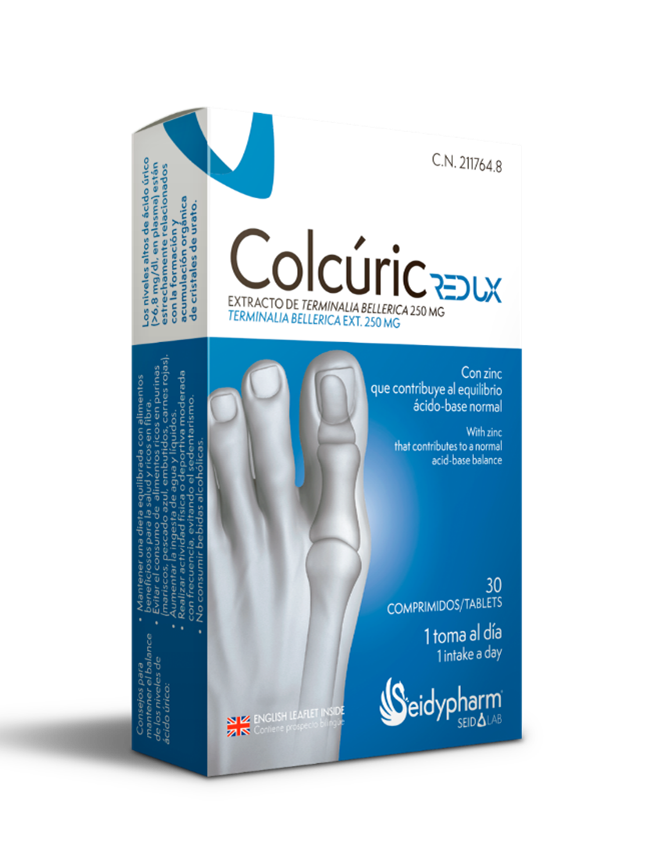Uric acid is a naturally occurring substance formed as a result of the breakdown of purines, chemical compounds present in some foods and in our own cells. When uric acid levels are kept in balance, uric acid dissolves in the blood and is excreted through the kidneys without causing problems.
However, an excess of uric acid can result in the formation of crystals in the joints and tissues, leading to a disorder known as gout. In this article, we will explore the role of uric acid in the body and look at dietary recommendations for natural control of uric acid levels.
Causes of elevated uric acid levels
Elevated uric acid levels in the body can be attributed to a variety of causes, some of which are related to overweight, type 2 diabetes or the use of diuretics and other drugs while others stem from dietary factors and underlying medical conditions.
Understanding the causes is essential to effectively address uric acid control and prevent complications such as gout, kidney stones, metabolic syndrome or hypertension. In this article we will focus on dietary factors and give you recommendations for controlling uric acid levels naturally.
Importance of diet in the control of uric acid
Diet plays a crucial role in regulating uric acid levels in the body. What you eat can significantly influence the production and elimination of uric acid, which in turn can affect your overall health.
Understanding how diet impacts uric acid production is essential for those seeking to maintain control of uric acid levels and prevent other associated diseases.
The role of purines
Diet is a key source of purines, which are broken down in the body to form uric acid. Foods rich in purines, such as red meat, shellfish and crustaceans, certain types of fish such as anchovies, salmon or anchovies; some vegetables such as spinach and leeks, or vegetables such as tomatoes, can raise uric acid levels.
Therefore, limiting or moderating the consumption of these foods is essential to keep uric acid levels in check. We will share a list of foods to avoid or reduce consumption later in this article.
Adequate hydration
Drinking enough water is essential to help the kidneys flush excess uric acid from the body. Dehydration can concentrate urine and increase the likelihood of uric acid crystals forming, which can lead to problems such as gout. Staying well hydrated is an effective strategy for maintaining healthy uric acid levels.
Varied and balanced diet
Eat a varied and balanced Mediterranean-style diet: high in fibre and low in saturated fat: whole grains, vegetables, olive oil, oily fish; moderate consumption of meat and meat products.
Increase consumption of dairy products: skimmed milk and, especially, cheese and yoghurt.

Moderation and planning
Moderation in diet is key. It’s not just about avoiding foods high in purines, but also about planning balanced meals that include a variety of essential nutrients. A balanced approach to diet can help you keep uric acid levels under control without depriving yourself of delicious and nutritious meals.
In short, diet plays a vital role in controlling uric acid in the body. By understanding how foods affect your uric acid levels and making consistent dietary choices, you can make a significant contribution to maintaining a healthy balance and preventing complications related to elevated uric acid levels.
In the following sections, we will delve into specific dietary recommendations to achieve these goals.
Which foods have uric acid
It is essential to understand which foods are rich in purines and therefore end up forming more uric acid in the body.
In excess, this can be harmful, especially for people prone to gout and other problems related to high uric acid.
Here is a list of foods that are known to be high in purines and should be consumed in moderation or avoided if you are looking to control your uric acid levels:
- Red Meats: Red meats, such as beef, lamb and pork, are known to be high in purines. If you enjoy these meats, try to limit your consumption and opt for lean cuts whenever possible.
- Offal: Organs such as liver, kidneys and heart contain particularly high levels of purines and should be consumed in moderation or avoided altogether.
- Seafood: Some seafood, such as anchovies, sardines, mussels and scallops, are high in purines. If you are a seafood lover, consider limiting your consumption and opt for lower purine options.
- Freshwater Fish: Freshwater fish such as trout and catfish also contain significant amounts of purines.
- Processed Foods: Some processed foods, such as sausages and canned meats, may contain purine-rich additives. Read food labels to identify these ingredients and consume them in moderation.
- Alcoholic beverages: Alcohol, particularly beer, can increase uric acid levels. Limit or avoid alcohol consumption if you are looking to control your uric acid.
While these foods are high in purines, they do not need to be completely eliminated from your diet unless you have a medical condition that requires it. Instead, consider reducing your intake and balancing your diet with low-purine foods, such as fruits, vegetables, low-fat dairy and whole grains.
Recommended foods for uric acid control
Maintaining healthy levels of uric acid in the body involves not only limiting the consumption of foods rich in purines, but also including foods that can help reduce the production or facilitate the elimination of this substance.
Choosing the right foods plays a key role in managing uric acid levels and preventing other related problems.
Here is a list of recommended foods that can help maintain a healthy balance of uric acid in your diet:
- Fresh Fruits: Fruits such as cherries, strawberries and citrus fruits are known for their ability to help reduce uric acid levels. These fruits contain antioxidants and vitamin C that can be beneficial.
- Vegetables: Include a variety of vegetables in your diet, such as carrots, broccoli and kale. These vegetables are low in purines and rich in essential nutrients.
- Low-fat dairy: Low-fat dairy products, such as yoghurt and milk, can be good choices. They can also help maintain adequate calcium levels.
- Whole Grains: Opt for whole grains instead of refined grains. For example, oats, brown rice and quinoa, which are rich in fibre and nutrients.
- Legumes: Beans, lentils and chickpeas are excellent sources of vegetable protein and can be part of a balanced diet.
- Nuts and Seeds: Walnuts, almonds and chia seeds are healthy choices that can supplement your diet and provide healthy fats.
- Avocados: Avocados are a source of monounsaturated fats and can be a delicious and healthy option in your diet.
These foods can be incorporated into a balanced and varied diet to help control uric acid. However, remember that each person may have specific dietary needs, so it is advisable to consult a healthcare professional or dietitian for personalised recommendations.
Pharmacodietary alternative for natural and effective control of uric acid levels1
Although convenient, a simple change in dietary habits alone will not achieve a sufficient reduction in plasma uric acid levels. However, it is possible to reduce and control excess uric acid effectively through the routine use of hypouricemic pharmaceuticals (e.g. Terminalia bellerica extract).
Colcuric REDUX® contains Terminalia bellerica extract, a naturally occurring alternative that has been shown in clinical studies to inhibit the enzyme xanthine oxidase, a catalyst directly involved in the production of uric acid.
In addition, the formula is supplemented with zinc, which contributes to normal acid-base balance.
Colcuric REDUX® will help you to reduce and maintain serum uric acid levels within normal parameters, preventing the formation of crystals in the body and thus avoiding the possible onset of conditions linked to excess uric acid.1
Bibliografía:
1 Usharani, P., Nutalapati, C., Pokuri, V. K., Kumar, C. U., & Taduri, G. (2016). A randomized, double-blind, placebo-, and positive-controlled clinical pilot study to evaluate the efficacy and tolerability of standardized aqueous extracts of Terminalia chebula and Terminalia bellerica in subjects with hyperuricemia. Clinical pharmacology: advances and applications, 51-59.
2 Diaz-Torne, C., & Diaz-Lopez, C. (2013). Eficacia y efectividad de los tratamientos reductores de la uricemia. Seminarios de la Fundación Española de Reumatología, 14(1), 8-13.
3 Zhang, Y., Liu, Y., & Qiu, H. (2018). Association between dietary zinc intake and hyperuricemia among adults in the United States. Nutrients, 10(5), 568.


